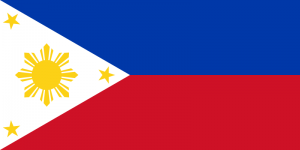
Philippines
Quick reference
General issues: Spanish colony 1854-1898, United States military administration 1898-1901, United States overseas territory 1901-1935, United States Commonwealth 1935-1942, United States Commonwealth 1945-1946, Republic 1946-present
Country name on general issues: None, Filipinas, Philippines, Philippine Islands, Pilipinas
Special issues: First Philippine Republic 1898-1899, Japanese administration 1942-1943, Japanese administration/Second Philippine Republic, local issues Leyte 1945
Related issues: Spanish West Indies 1856
Currency: 1 Real = 20 Cuartos 1854-1864, 1 Peso = 8 Reales = 100 Centimos 1864-1870, 1 Escudo = 100 Centimos 1870-1872, 1 Peseta = 100 Centavos 1872-1876, 1 Peseta = 100 Centomos = 1000 Milesimas 1876-1899, 1 Dollar = 100 Cent 1899-1906, 1 Peso = 100 Centavos 1906-1962, 1 Piso = 100 Sentimos 1962-present
Population: 7 409 000 in 1900, 98 390 000 in 2013
Political history Philippines
The Philippines are an archipelago located in southeastern Asia. The Philippines are, from 1565, a Spanish colony – part of Spanish East India of which the Caroline Islands, Guam and the Mariana Islands are also part. In 1898, a conflict over Cuba escalates into the Spanish-American war that spills over to the Spanish territories in Asia and Oceania. In 1898, the United States occupy Manila, the capital of the Philippines. In the treaty that ends the war in 1898, Spain cedes the Philippines and Guam to the United States and the Caroline and Mariana Islands to Germany. After three years of United States military administration, the Philippines become a United States overseas territory, a status that would equal that of a colony with direct United States civil administration.
Before the outbreak of the Spanish-American war, the Filipinos had revolted for the first time against Spanish colonial rule in 1896. During the Spanish-American war, the Filipinos again revolt and proclaim independence as a republic. The first seat of the republic is Malolos. In Philippine history this is known as the First Philippine Republic. An armed conflict evolves that results in a United States victory. In 1902, the First Philippine Republic – then seated in Palanan – is dissolved.
In 1935, the Philippines become a self governing state as a United States Commonwealth. A Philippine constitution is adopted that grants the Philippines self government in domestic affairs, while foreign affairs remain in the hands of the United States.
In 1941, the Japanese invade the Philippines and in 1942 occupy the entire country. In 1943, the Japanese in the Philippines – like elsewhere – install a nominally independent republic, the Second Philippine Republic. The Allied counter attack against the Japanese reaches the Philippines in 1944 – Leyte being the first island to be liberated. In 1945, the Second Philippine Republic is dissolved and United States rule is restored. The Philippines are on the road to independence, and in 1946 the fully independent and internationally recognized Third Philippine Republic is established.
The government of the Philippines has for decades been facing different ethnically or politically driven insurgent groups in the archipelago. Economically, the Philippines, have since independence, been outperforming many other countries in southeastern Asia. After a downward streak in the 1960’s, reforms in the 1990’s seem to be again improving the Philippine economy.
Postal history Philippines
The first stamps used in the Philippines are issued in 1854 by the Spanish colonial administration. The stamps do not bear the name of the country until 1872. In 1856, due to shortages, stamps issued for the Spanish West Indies in 1855 are used – also not bearing the name of the country and only to be recognized by the cancels. The first issues are for domestic use. Until the Spanish colonies become a member of the U.P.U. in 1877, foreign mail is routed through a British office in Manila using stamps from British India, later Hong Kong and the Straits Settlements. The First Philippine Republic issues stamps in 1898 and 1899. Under United States military administration, from 1898, first stamps from the Spanish colonial era and from the United states are used without overprint. As of 1899, United States stamps with an overprint reading ‘Philippines’ are issued.
The first stamps designed specifically for the Philippines are issued in 1906. Until independence is gained in 1946, stamps are inscribed with the country names of both the United States and the Philippines.
During the occupation by Japan, stamps are issued by the Japanese administration from 1942. These are Philippine stamps overprinted with bars and a new face value, later with overprints in Japanese and definitives in Japanese. From 1943, stamps are issued by the Second Philippine Republic. These bear the name of the country in Latin script: Pilipinas.
After the recapture of the Philippines by the United States, the first stamps issued are local overprints on pre-war issues on the island of Leyte in 1944. The overprint reading ‘Victory’. In 1945, stamps with the same overprint are issued for all of the Philippines. As of its independence in 1946, the republic of the Philippines has issued stamps.
Album pages
← Previous page: PalestineNext page: Portuguese India →

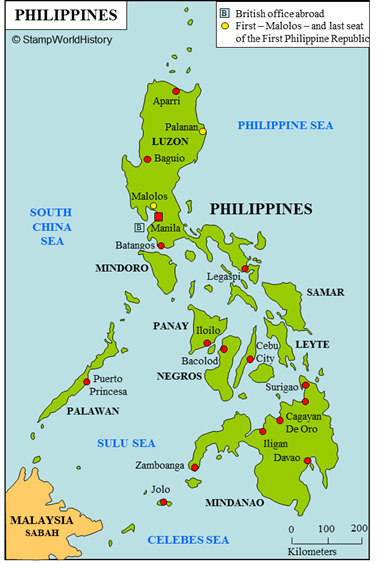
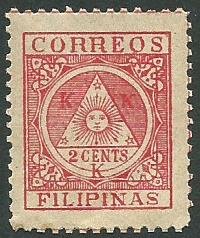
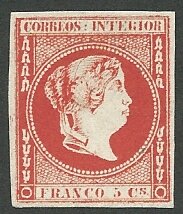
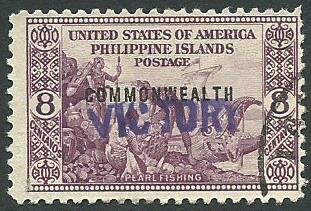
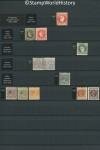

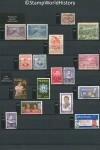
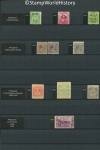
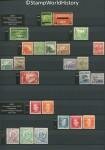
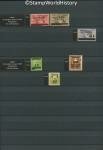
Throughout the text “Manilla” should be “Manila” as on the map.
William
Thanks. Manila is spelled Manilla in Dutch. It odd how sometimes Dutch creeps in when writing the profiles…..